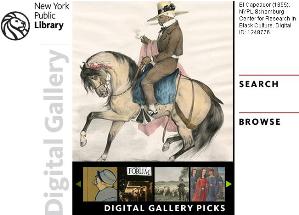 In a move that will allow libraries and independent software developers to write programs accessing over one million digital objects and records, the New York Public Library this week released an application programming interface (API) that facilitates connection to the NYPL Digital Gallery.
In a move that will allow libraries and independent software developers to write programs accessing over one million digital objects and records, the New York Public Library this week released an application programming interface (API) that facilitates connection to the NYPL Digital Gallery.
David Riordan, product manager for NYPL Labs, explained the origin of the Digital Collections API to LJ: “Over the past few years, as NYPL Labs has been launching our succession of public projects, NYPL’s Information Technology Group has been building the digital equivalent of our physical stacks, the NYPL Repository, where all the library’s digitized assets live, get preserved, and are managed. All of which is pretty cool, assuming there’s a way for us to work with these things, and by us, I mean our computers and the applications we build.”
So, the NYPL Repository group built the API to help NYPL Labs power its next generation of collection-based applications. The rationale for also releasing the API to the public was simple, Riordan said.
“As a public library, we felt a responsibility to make this same data available to the public.”
Basically, APIs help different software components “talk” to one another. In this case, the Digital Collections API will allow computer programs to “search our digital collections, process the descriptions of each object, and find links to the relevant pages on the NYPL Digital Gallery,” according to NYPL’s blog post about the launch.
“As a human, you can already do that using the Digital Gallery itself, but you can only perform one search at a time,” writes Doug Reside, NYPL’s Digital Curator of Performing Arts. “If you wanted to make a chart of say, the most commonly occurring words in the titles of the Mid-Manhattan Picture Collection, it would take a while. Now that the API makes this data available to computer programs, though, it wouldn’t take a great deal of coding to generate such a chart.”
For now, direct access to most of the images in the digital gallery is not included in the API, Riordan said.
“We tell you how to get to where the image is, but we don’t give a direct link to the image itself.”
However, there will be cases where access to the images in specific collections will be encouraged. For example, the API makes NYPL’s collection of digitized public-domain maps available as high-resolution, archival quality TIFF files.
“We see some other collections where that [type of access] is hopefully going to be possible pretty soon as well,” Riordan said.
According to Riordan, the API has already attracted a lot of positive attention since its April 3 release. When people sign up for the API, NYPL asks how they are planning to use it, and responses have run the gamut so far. For example, one user planned to explore the possibility of accessing New Zealand-related metadata in NYPL’s collections, and representing it within New Zealand’s Digital NZ. Another user wanted to use the Alfred quick-launch desktop app for Macs to search NYPL’s digital collections.
“It took a while for people to start building things on top of Menus [NYPL Labs “What’s on the Menu?” API], but with this, people are starting to do new things immediately. It’s really, really exciting,” said Riordan.


